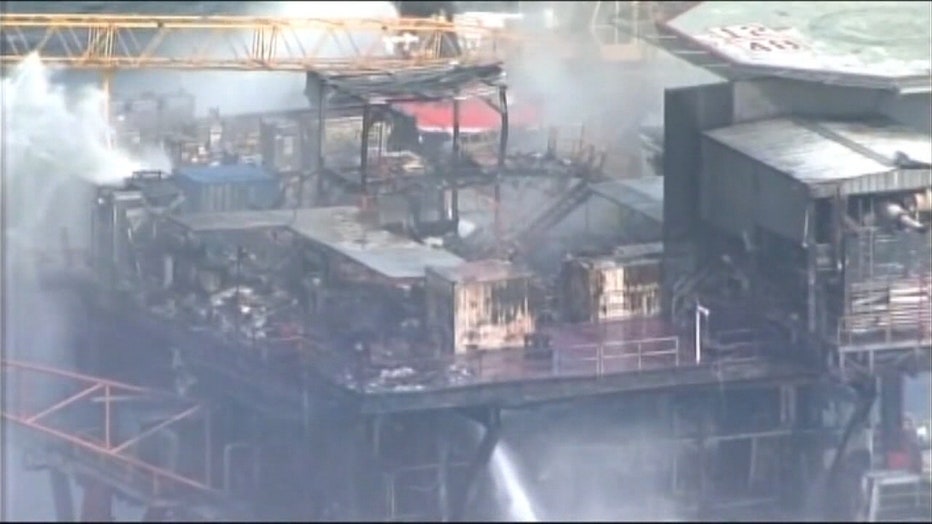Ten years after BP spill: Oil drilled deeper; rules relaxed

Deepwater Horizon Disaster still impacting marine life
Ten years ago, an accident on an oil rig in the Gulf of Mexico left 11 people dead and resulted in the largest marine oil spill in history. The USF College of Marine Science is conducting a study on the long-term effects, and found a substantial of oil is still in the environment.
Ten years after an oil rig explosion killed 11 workers and unleashed an environmental nightmare in the Gulf of Mexico, companies are drilling into deeper and deeper waters, where the payoffs can be huge but the risks are greater than ever.
Industry leaders and government officials say they’re determined to prevent a repeat of BP’s Deepwater Horizon disaster. It spilled 134 million gallons of oil that fouled beaches from Louisiana to Florida, killed hundreds of thousands of marine animals and devastated the region’s tourist economy.
Yet safety rules adopted in the spill’s aftermath have been eased as part of President Donald Trump’s drive to boost U.S. oil production. And government data reviewed by The Associated Press shows the number of safety inspection visits has declined in recent years, although officials say checks of electronic records, safety systems and individual oil rig components have increased.
Today companies are increasingly reliant on production from deeper and inherently more dangerous oil reserves, where drill crews can grapple with ultra-high pressures and oil temperatures that can top 350 degrees (177 degrees Celsius).
Despite almost $2 billion in spending by the industry on equipment to respond to an oil well blowout like BP’s, some scientists, former government officials and environmentalists say safety practices appear to be eroding. And there are worries that cleanup tactics have changed little in decades and are likely to prove as ineffective as they were in 2010.
“I’m concerned that in the industry, the lessons aren’t fully learned — that we’re tending to backslide,” said Donald Boesch, a marine science professor at the University of Maryland who was on a federal commission that determined the BP blowout was preventable.
PHOTOS: Coast Guard team flies over Deepwater Horizon site (2010)
Regulators and industry leaders say they’ve employed lessons from the April 20, 2010, disaster to make deep-water drilling safer by setting tougher construction and enforcement standards.
“I think the event 10 years ago really initiated kind of a new day in offshore safety,” said Debra Phillips, of the American Petroleum Institute, a standards-setting trade association.
____
Companies have a financial interest in preventing a repeat of the 2010 disaster, which cost BP more than $69 billion in cleanup, fines, fees and settlements. Questions over environmental effects linger, and litigation continues over health problems suffered by cleanup workers.
Competing oil giants joined in the disaster’s wake to create the Marine Well Containment Co., which has equipment and vessels positioned regionwide to quickly corral oil if another major spill occurs.

“All of (the) industry wanted to make sure that nothing like it could ever happen again,” said CEO David Nickerson, at the company’s complex near Corpus Christi on Texas’ coast.
He was dwarfed by “capping stacks”″ — multistory structures of piping, valves and gauges designed to be lowered to halt a major high-pressure blowout.
The hope is that such equipment won’t be needed. Yet the Trump administration has relaxed rules adopted in 2016, including the frequency of drilling rig safety tests. That’s projected to save energy companies roughly $1.7 billion in compliance costs over a decade.
An AP review found the number of safety inspection visits by the U.S. Bureau of Safety and Environmental Enforcement — created after the spill — went down more than 20% over the past six years in the Gulf.
Industry advocates say inspection figures reflect greater emphasis on complex systems that influence safety rather than minor technical matters, and note there are fewer, if bigger, active oil platforms. They say the administration’s rule changes allow companies to deviate from “one-size-fits-all” standards not always suited to water pressure and other conditions at individual wells.
“Sometimes, when the regulations are quite prescriptive, it can actually inadvertently deteriorate safety,” said Phillips, of the American Petroleum Institute.
Read more on APNews.com

